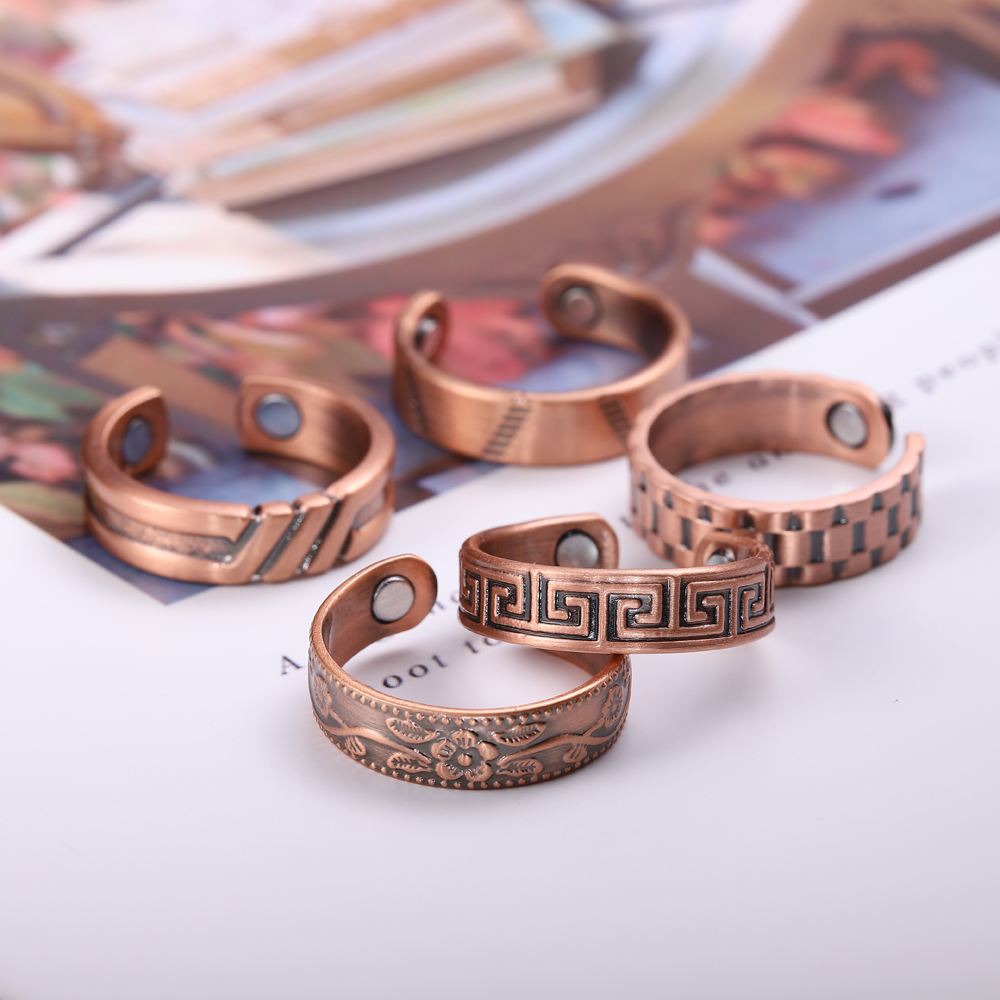Copper, Brass, and Bronze are used in the production of body jewelry. The main difference between them is the composition of the elemental metals.
But is this the only difference you might ask? What about the color? Are there any pros and cons? Well, keep reading and all your questions will be answered.
What is copper?
Copper, represented by the atomic number 29 and symbol ‘Cu’, is one of the most popular metals in the world. Copper is found naturally in the earth and typically sports a red-brown color. It is a good conductor of heat and electricity and plays a crucial role in the day-to-day activities ranging from air conditioning, and cookware, to automotive parts and power utilities.
Copper is not the strongest of materials, but it is not an understatement to say that it is very tough and malleable. It is exactly because of these properties that copper has been widely used in jewelry making for generations.
Copper color
Pure copper is normally orange-red in appearance. When it is exposed to air, oxidation occurs making it acquire a more reddish color.
Copper composition
The most popular form of pure copper is comprised of:
- 99.95% copper
- 0.03% oxygen
- trace amounts of metallic impurities (less than 50ppm).
Copper jewelry pros and cons
| Pros | Cons |
| Versatility: Copper is very malleable. You can mold, bend and form copper easily so there is a variety of styles and designs. | Discoloration: The main disadvantage associated with copper jewelry is the possibility of it turning your skin green. |
| Affordability: Not only is there a variety of designs available, but copper is also relatively affordable compared to other metals. | Durability: As mentioned before, copper is a soft, malleable metal. This means it is more prone to scratching, bending, and breaking compared to other metals. |
| Health Benefits: Copper is not only good for fashion, but it is also good for your health. It has anti-aging properties, relieves pain, is good for balance, and is good for heart health. | Copper Allergy: These are very rare, but they do sometimes happen. Copper can irritate the skin, forming red spots, in certain individuals. If you’re allergic, then this might not be for you. |

What is Brass?
Brass is a copper alloy containing copper, zinc, and small amounts of other metals. Zinc is added to copper to increase its durability and strength, it is stronger than pure copper. Depending on the other metals added, the copper alloy will have other enhanced characteristics. For example, adding lead will lead to improved machinability.
Brass color
Brass has a strong yellow color almost like gold. It’s typically grayish-yellow to reddish-yellow.
Brass composition
Brass is typically comprised of copper and zinc with trace amounts of other elements such as:
- Tin
- Iron
- Lead
- Aluminum
- Silicon
- Manganese
As the metal composition changes, so do the properties of the metal alloy. Depending on the desired properties of the metal alloy, different metals would be combined. For example, if a strong alloy is desire
Brass jewelry pros and cons
| Pros | Cons |
| Beautiful tone: it has a beautiful golden shine like gold making it a piece of stunning and elegant jewelry. | Non-hypoallergenic: Brass, being a non-hypoallergenic metal, can cause people with sensitive skin to experience rash, flaking, and itchiness. Of course, applying a finish to the jewelry can prevent this issue |
| Durable: While brass is very pliable, it is by no means a weak metal. It has incredible tensile strength meaning that brass jewelry will not break easily. | Tarnishes: Brass jewelry that is unfinished will tarnish after a while. As time passes, it will lose its sheen and a greenish layer will form (oxidation of copper). So, it’s best to get your brass jewelry a finish. |
| Affordable: Brass jewelry is pocket-friendly which makes it even more attractive. You can get a strong stunning piece of jewelry for a low price. | |
| Corrosion-resistant: Brass contains non-corrosive metals: copper and zinc. Hence, brass jewelry will not rust or corrode. |
What is bronze?s bronze?
Bronze is a copper alloy containing copper, tin, and small amounts of other metals. Like brass, depending on the other metals added, bronze will have improved characteristics. Bronze portrays most of the characteristics of copper and brass (low friction coefficient and corrosion resistance) while also exhibiting distinct properties such as greater brittleness and higher melting point than both copper and brass.
Bronze, with its malleability and appealing color, is used to create musical instruments, jewelry, and sculptures.
Bronze color
Bronze is typically a metallic brown color signifying its stability and earthiness.
Bronze composition
Bronze is typically composed of copper, tin, and other trace metals such as aluminum and phosphorus. This essentially means that there are different bronze alloys. However, modern bronze is typically 12% tin and 88% copper.
Bronze jewelry pros and cons
| Pros | Cons |
| Versatile: You can mold, bend and form bronze easily so there is a variety of styles and designs. In addition, it can be worn with a variety of different outfits and colors. | Nickel Allergies: Some bronze jewelry might contain traces of nickel which is a common skin allergen. |
| Health benefits: Bronze jewelry is a relatively good source of copper. Studies have shown that it helps to relieve joint pain, arthritis, rheumatism, and other health conditions. | Tarnishes: Bronze jewelry will tarnish and change color after a while. You can coat it with nail polish to prevent this. |
| Pocket-friendly: You can get a strong, stunning, and versatile piece of bronze jewelry for a low price. |
Brief Summary Table
| Property | Copper | Brass | Bronze |
| Color | Orange-red | Yellow | Metallic brown |
| Yield strength | 33.3 MPa | 34.5 to 683 MPa | 140 MPa |
| Tensile strength | 220 MPa | 360 MPa | 350 MPa |
| Use | Cables, wires, jewelry | Door knobs, jewelry, valves, nuts | Sculptures, musical instruments, medals, jewelry |
| Cost | Most expensive | Least expensive | More expensive than brass but less than copper. |
| Durability | Poor | Good | Normal |
Why choose 99.9% solid copper for magnetic bracelets?
Why? It is good for the body. Studies show that copper promotes several health benefits while magnetic therapy improves certain conditions. Copper is an essential mineral which helps to keep the body healthy. It has a lot of health benefits, a few of which include:
1) Relieving Arthritis: Copper metal triggers anti-inflammatory properties within the body to relieve pain and cure arthritis. It is good for swellings, general body pain, and strengthening the muscular system.
2) Anti-aging Properties: The chemicals that produce toxins in the body, causing it to age fast, are known as radicals. Copper contains antioxidants that help to fight against these radicals. It also helps to produce collagen, which aids in the antiaging process.
3) Good for Cardiovascular health: A copper a day, keeps the doctors away. When you wear copper jewelry, properties are absorbed into the body’s circulatory system helping it to remove toxins and produce hemoglobin.
So, by combining 99.9% pure copper with magnets, the healing efficiency is increased.

How to tell it is pure copper from brass and bronze?
There are three simple methods you can use to differentiate between the pure copper, brass, and bronze.
1) Color: One proven method to differentiate copper from brass and bronze is to use a white fluorescent light bulb or the sunlight. While holding the metal/product under the light, you should get a reddish-brown hue if it is pure copper. On the other hand, brass and bronze will have a yellow-brown color.
2) Sound: By lightly striking the metal, you can easily differentiate pure copper from brass and bronze. Copper will normally produce a low, deep sound while bronze and brass will produce a higher pitched sound. Brass will produce the highest pitched sound.
3) Durability: Copper in its purest form is hard to crack, but it is capable of bending and stretching. On the other hand, bronze is not as flexible and requires a lot of effort to bend or stretch. Finally, brass is stronger than the two and is not flexible at all. So, by trying to bend or stretch the metal, you will be able to differentiate pure copper from brass and bronze.

Final Thoughts
Copper, Brass, and Bronze are all popular metals in the jewelry market. They are versatile, affordable, and durable and all of them have a stunning appearance. If we were to decide which is the best out of the three, it would be hard to say. It’s dependents on what styles you choose and what benefits you expect.


